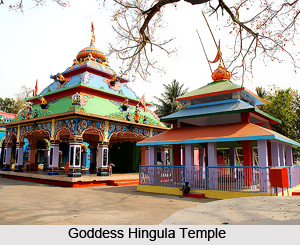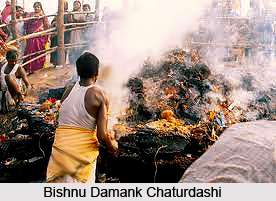 Goddess Hingula temple is situated in Angul district, in the state of Odisha along the bank of river Simhada. It stands exactly in a village named Gopalprasad. The famous poet Sarala Das, in fifteenth century A.D, has mention about Goddess Hingula in his Mahabharata. He described the deity as the manifestation of Goddess Sarala. Goddess Hingula is considered very powerful and through strong devotion towards the deity one can fulfil all his wishes. Mahabharata also states that King Nala of Vidarbha used to worship Goddess Hingula and the goddess was also associated with cooking. The goddess was also worshipped by the successors of King Nala through generations.
Goddess Hingula temple is situated in Angul district, in the state of Odisha along the bank of river Simhada. It stands exactly in a village named Gopalprasad. The famous poet Sarala Das, in fifteenth century A.D, has mention about Goddess Hingula in his Mahabharata. He described the deity as the manifestation of Goddess Sarala. Goddess Hingula is considered very powerful and through strong devotion towards the deity one can fulfil all his wishes. Mahabharata also states that King Nala of Vidarbha used to worship Goddess Hingula and the goddess was also associated with cooking. The goddess was also worshipped by the successors of King Nala through generations.
Legends of Goddess Hingula Temple
Although the temple of Goddess Hingula is situated at Gopalprasad, its daily rites bear strong resemblance with that of the temple of Lord Jagannath at Puri. A legend says that once Queen Gundicha thought to introduce sixty courses of food as offering to Lord Jagannath. His king however had a dream in which the lord himself ordered him to worship Goddess Hingula so that the cooking can be conducted smoothly. Thus the king went to Vidarbha to bring the Goddess to Puri with the help of King Nala. A strange incident however took place on the way when they were taking rest at the bank of river Singhada at Gopalprasad. The idol of the goddess suddenly disappeared and a voice declared Gopalprasad as the holy place of Goddess Hingula.  The voice further announced that the two associates of the goddess, Kuteisuni and Karadei, to be worshipped here too. Thus the place where the incident took place became the site where the offerings of Lord Jagannath were cooked. Later, Gopalprasad became the abode of Goddess Hingula and for preparing offerings for Lord Jagannath at Puri, a sacrifice is offered to the goddess before litting the fire in the kitchen. Goddess Hingula is worshipped in the form of fire.
The voice further announced that the two associates of the goddess, Kuteisuni and Karadei, to be worshipped here too. Thus the place where the incident took place became the site where the offerings of Lord Jagannath were cooked. Later, Gopalprasad became the abode of Goddess Hingula and for preparing offerings for Lord Jagannath at Puri, a sacrifice is offered to the goddess before litting the fire in the kitchen. Goddess Hingula is worshipped in the form of fire.
Festivals in Goddess Hingula Temple
Goddess Hingula temple forms the prime pilgrimage centre for the devotees of Deogarh, Pallahara, Dhenkanal, Hindol, Athamallik, Angul and many other places. During autumn and spring seasons, special worships are organized in the temple. Bishnu Damank Chaturdashi marks the main worship day of Goddess Hingula which is observed in the month of Chaitra. The principle worshippers, known as Dehury, during this festival stay away from their families, in the temple. During the month of Chaitra, another festival is observed in the temple every Thursday which is referred as Jantal Puja. As the goddess is seen in the form of fire `Sabari Mantra` is chanted by Dehury and fire is lit on Charapthar (char/coal). An applique is fixed over four bamboos by the people of kandha tribe at the place of worship after the fire is put off. The festival is attended by the people belonging to all the castes without any discrimination. A mobile image of god, also known as Alam is brought from the temple at a big `pendal` where the worship is performed. This is done in a procession of devotees accompanied by instruments like drums, cymbals, conchs etc. Saradiya or Dasahara festival is another significant festival in which the Alam is taken form the temple to the Dasahara ground where worship is performed. The fire festival is observed in the month of Phalguna. It is believed that during this festival Goddess Hingula meets Durga Madhava.





















